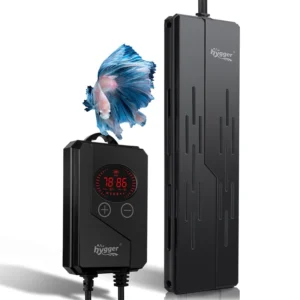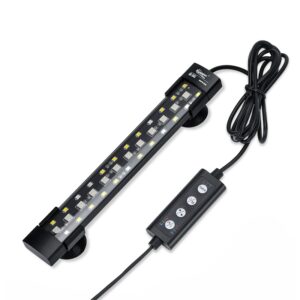Captivating with their dazzling colors and playful personalities, platy fish is a popular choice for home aquariums. But these little wonders offer more than just mesmerizing aesthetics! Whether a seasoned aquarist or an enthusiastic beginner, this comprehensive guide unveils everything you need about platy fish care.
Content Table

What is the Platy Fish
Platy fish are popular freshwater aquarium fish known for their bright colors and easy care requirements. They are a great choice for beginner fish keepers due to their hardy nature and peaceful temperament. Platy fish are a type of livebearer, meaning they give birth to live young rather than laying eggs.
Types of Platy Fish
There are several different types of platy fish, including the sunset platy, red wag platy, and Mickey Mouse platy. Each platy fish type has its unique coloration and markings, making them a popular choice for aquarists looking to add variety to their tank.
Origin and Habitat
Platy fish are native to Central America and can be found in rivers and streams with slow-moving water. They are typically found in a variety of habitats, including dense vegetation and rocky areas. In the aquarium, platy fish thrive in well-planted tanks with plenty of hiding spots and room to swim.
Diet and Feeding
Platy fish are omnivores and will eat a variety of foods, including flakes, pellets, and live or frozen foods. A varied diet that includes both plant matter and protein will help keep your platy fish healthy and happy. It’s important not to overfeed them, as this can lead to health issues and poor water quality in the tank.
Platy Fish Lifespan
Under ideal conditions, platy fish can live for 3 to 4 years. By providing proper care and attention to these factors, you can maximize your platy fish’s lifespan and ensure they live a long and healthy life.

How Long Are Platyfish Pregnant For?
Female platyfish are typically pregnant for about 4–6 weeks. During this time, you may notice the female fish developing a rounded belly as the fry grows inside her. It’s important to provide a stress-free environment for the pregnant platy fish to help ensure a successful pregnancy.
As the pregnancy progresses, you may notice the gravid spot on the female platy fish darkens. This is a sign that she is close to giving birth. The female fish may also become more reclusive or display labor-like behavior, such as hiding in plants or rocks.
Care Tips for Pregnant Platy Fish
1. Provide Ample Hiding Spots
Pregnant platyfish may seek out hiding spots to feel safe during labor. Decorate your aquarium with plants, rocks, or caves to give them places to retreat to.
2. Maintain Water Quality
Keep the water in your aquarium clean and well-maintained to reduce stress on the pregnant platy fish. Perform regular water changes and monitor water parameters such as pH, ammonia, and nitrate levels.
3. Offer a Varied Diet
Feed your pregnant platy fish a balanced diet that includes high-quality flakes, pellets, and live or frozen foods. Providing nutritious food will help support the health of both the mother and the developing fry.
4. Separate the Fry
Once the female platy fish has given birth, it’s important to separate the fry from the adult fish to prevent them from being eaten. You can transfer the fry to a separate tank or provide floating breeding traps in the main aquarium.

Keeping Care Advice for Platy Fish
Tank Size
Platy fish are small, peaceful freshwater fish that do well in tanks of at least 10 gallons. They are social creatures, so it’s best to keep them in groups of 3 or more.
Water Conditions
Platy fish prefer slightly alkaline water with a pH level between 7.0 and 8.0. The water temperature should be between 72-78°F. Regular water changes are important to maintain good water quality.
Feeding
Platy fish are omnivores and will eat a variety of foods. A balanced diet should include high-quality flakes or pellets, as well as occasional treats like bloodworms or brine shrimp. Feed them small amounts 2–3 times a day, only what they can consume in a few minutes.
Tank Setup
Platy fish enjoy having plants and decorations in their tank to provide hiding spots and areas to explore. Make sure there are no sharp edges that could injure them. A filter is necessary to keep the water clean, and a heater may be needed to maintain the right temperature.
Behavior
Platy fish are peaceful and get along well with other community fish. They are active swimmers and enjoy exploring their environment. Keep an eye out for any signs of aggression or illness, as they can be indicators of problems in the tank.
Tank Mates of Platies
Platy fish are generally peaceful community fish, but they can exhibit fin-nipping behavior towards other fish, especially those with long-flowing fins. To ensure a harmonious and thriving aquarium, choosing the right tank mates is crucial. Here’s what you need to keep in mind:
Factors to Consider
| Size | Choose tank mates of similar size to avoid predation |
| Temperament | Opt for peaceful and non-aggressive fish to prevent conflicts |
| Water parameters | Select fish with compatible water temperature, pH, and hardness preferences |
Compatible Tank Mates
- Livebearers: Mollies, guppies, and swordtails are excellent choices as they share similar needs and behaviors.
- Small Tetras: Neon tetras, ember tetras, and harlequin rasboras are peaceful and add vibrant color to the tank.
- Corydoras Catfish: These bottom feeders, corydoras catfish, are peaceful scavengers and help maintain clean substrate.
- Bristlenose Plecos: These algae eaters plecos contribute to tank maintenance while remaining peaceful.
- Rainbowfish: Choose dwarf species like the dwarf neon rainbow fish to avoid competition and aggression.

Things to Avoid
- Large or aggressive fish: These can intimidate and harm platy fish.
- Fin nippers: Fish-like barbs and some cichlids are known to nip fins, causing stress and injury.
- Slow-moving fish: Platys can be energetic and might outcompete slower fish for food.
Minimizing Fin Nipping
- Provide ample hiding places like plants, caves, and driftwood.
- Maintain a well-fed and healthy community to reduce competition.
- Introduce new fish gradually to minimize territorial disputes.


Leave a comment